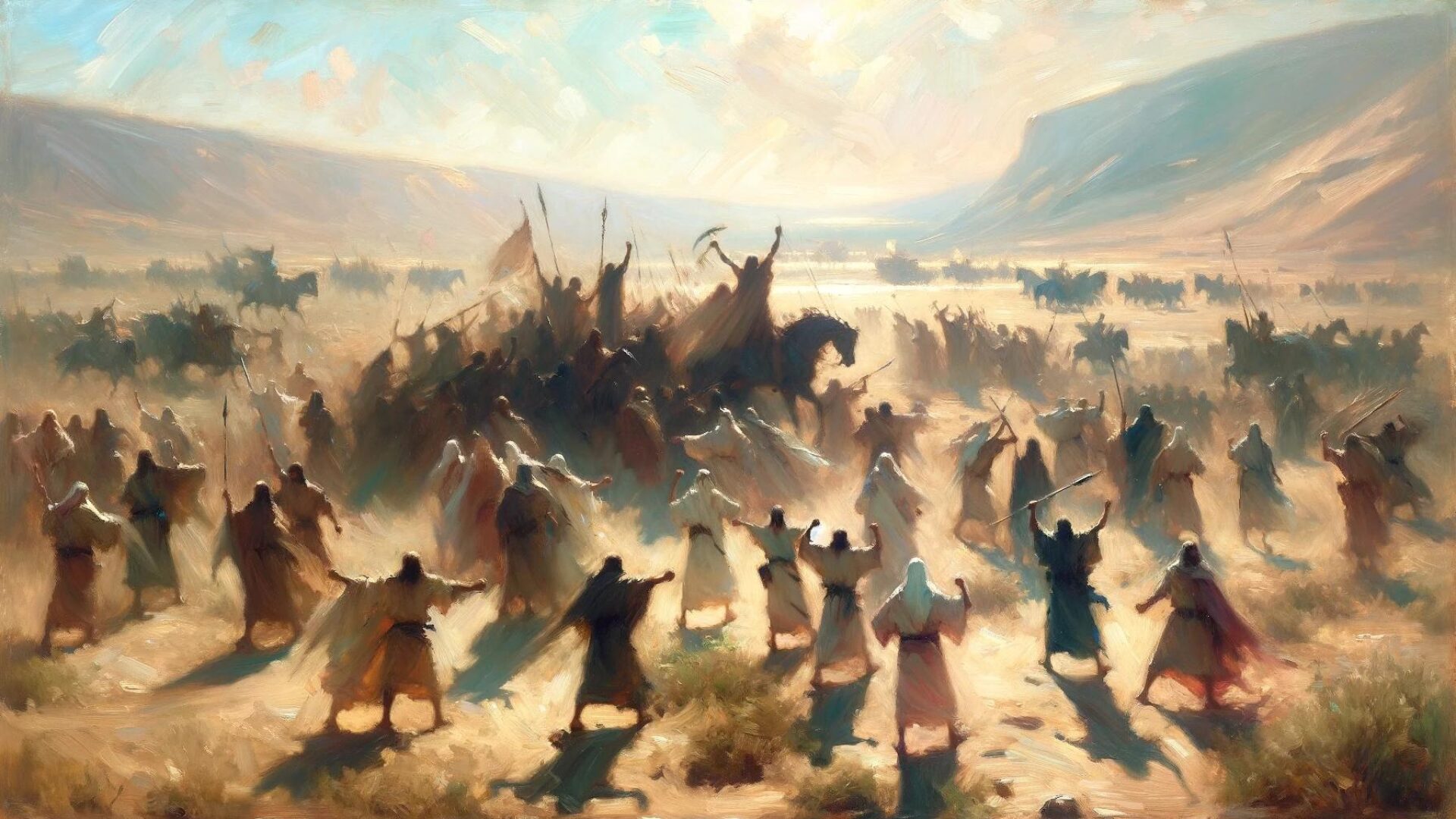The Transfiguration of Jesus is one of the most profound events in Christian history. This miraculous event is not only a demonstration of Jesus’ divine power but also a symbol of his spiritual significance. In this section, we will explore the meaning of the Transfiguration of Jesus and its significance in Christianity. We will dive into the biblical accounts of the transfiguration and define what it entails.
The Transfiguration story can be found in the New Testament books of Matthew, Mark, and Luke. According to these accounts, Jesus takes three of his disciples – Peter, James, and John – up a mountain, where he is suddenly transfigured before them. His face shone like the sun, and his clothes became as white as light. He is then joined by two Old Testament figures, Moses and Elijah, who talk with him. The disciples are overwhelmed by the experience and offer to build shelters for the three figures, but a voice from heaven declares Jesus as God’s Son and tells them to listen to him. The vision fades, and Jesus and his disciples return to the valley.
Key Takeaways:
- The Transfiguration of Jesus is a significant event in Christianity, symbolizing his divine power.
- The story can be found in the New Testament books of Matthew, Mark, and Luke.
- Jesus was transfigured on a mountain and appeared alongside Moses and Elijah.
- The disciples were overwhelmed by the experience and offered to build shelters for the figures.
- A voice from heaven declared Jesus as God’s Son, and the disciples were told to listen to him.
The Transfiguration in the Bible: A Divine Revelation
The Transfiguration of Jesus is a significant event in the Bible that is often overlooked. According to the Gospels of Matthew, Mark, and Luke, Jesus took three of his disciples, Peter, James, and John, up to a high mountain where he was transfigured before them. His face shone like the sun, and his clothes became dazzling white.
The significance of this event is that it reveals Jesus’ divine nature and his identity as the Son of God. The transfiguration served as a manifestation of God’s glory and power, and it was a foreshadowing of Jesus’ resurrection and his ultimate triumph over sin and death.
The transfiguration also emphasizes the importance of listening to Jesus. When the disciples witnessed the transfiguration, a voice from heaven said, “This is my Son, the Beloved; listen to him!” This message underscores the need for believers to pay attention to Jesus’ teachings and follow his example.
The Transfiguration in Christianity
The transfiguration holds great significance in Christian theology and is often celebrated as a feast day in various denominations. It is a reminder of Jesus’ divine nature and serves as a symbol of hope and transformation for believers.
The interpretation of the transfiguration varies among different Christian traditions. Some interpret the event as a glimpse of heaven, while others view it as a confirmation of Jesus’ role as the Messiah. Regardless of its interpretation, the transfiguration remains a powerful illustration of Jesus’ divinity and the transformative power of faith.
The Transfiguration Story
The transfiguration story is detailed in Matthew 17:1-13, Mark 9:2-13, and Luke 9:28-36. These accounts portray Jesus’ transfiguration as a miraculous event that occurred in the presence of his closest disciples.
During the transfiguration, Jesus was joined by Moses and Elijah, two important figures from Jewish history. Moses represented the law, while Elijah represented the prophets, and their presence emphasized the continuity between the Old Testament and the New Testament.
After the transfiguration, Jesus instructed his disciples not to tell anyone about the event until after his resurrection. This instruction was significant because it showed that Jesus understood the timing of his mission and the role that the transfiguration would play in his message.
Understanding the Spiritual Meaning of Jesus’ Transfiguration
The Transfiguration of Jesus holds deep spiritual significance in Christianity. It is a remarkable event that offers a glimpse into Jesus’ divine nature and the true identity of the Son of God. The transfiguration story, as recounted in the bible, is a powerful message of faith and serves as a foundation for Christian theology.
There are various interpretations of the Transfiguration of Jesus. Some see it as a revelation of Christ’s glory, while others view it as a symbol of transformation and renewal. However, at its core, the transfiguration is a spiritual experience that transcends human understanding.
“The Transfiguration leads us to contemplate the Lord’s divinity amidst a setting of divine glory. It invites us to deepen our faith and to consider the profound mystery of God’s saving plan.” – Pope Francis
Jesus’ transfiguration is a symbolic representation of his divine nature, and it serves as a validation of his message and teachings. It is through the transfiguration that Jesus is revealed as the Son of God and the way to salvation for all humanity. The experience of the Transfiguration confirms the unbreakable bond between the Father and the Son and demonstrates the truth of Jesus’ message.
Through the Transfiguration, we see the powerful connection between Jesus, God, and the Holy Spirit. It is a moment of spiritual transformation that provides insight into the nature of God and the relationship between God and humanity. By contemplating the spiritual meaning of Jesus’ transfiguration, we can deepen our understanding of the Christian faith and draw closer to God.
The Symbolic Significance of the Transfiguration
The Transfiguration of Jesus is a significant event in Christianity that has been interpreted in many ways throughout history. Its symbolic significance allows us to gain a deeper understanding of the divinity of Jesus and his teachings.
One of the most significant symbols in the Transfiguration story is the presence of Moses and Elijah. Moses represents the Old Testament Law, while Elijah represents the prophets. Together, they signify the fulfillment of the Law and the Prophets through Jesus. The appearance of these two figures to the disciples is a sign that Jesus is not simply a prophet, but rather the fulfillment of all that came before him.
Another important symbol is the cloud that appears over Jesus and the disciples. This cloud represents the presence of God and symbolizes the divine nature of Jesus. The voice from the cloud, which proclaims “This is my beloved Son, with whom I am well pleased; listen to him,” emphasizes the divine nature of Jesus and his importance as the Son of God.
Finally, the shining face and clothes of Jesus in the Transfiguration story represent his divine glory and radiance. This symbolizes the glory of God that Jesus will reveal to his followers and emphasizes his transcendence above ordinary human existence.
The Transfiguration of Jesus is a complex event with many layers of symbolism and meaning. By understanding the symbolic significance of this event, we can gain a greater appreciation for Jesus’ divinity and the meaning of his teachings in the context of Christianity.
Conclusion
Throughout this article, we have explored the spiritual and symbolic significance of the Transfiguration of Jesus. We have analyzed the biblical accounts of this miraculous event and sought to understand its deeper meaning within the context of Christianity. By examining the symbolism present in the transfiguration, we can gain a greater appreciation for the spiritual message conveyed through this divine revelation.
At its core, the Transfiguration of Jesus represents a powerful affirmation of his divinity and the truth of his teachings. It serves as a testament to the transformative power of faith in Christ and the potential for spiritual enlightenment that lies within each of us. Through the symbolism of the transfiguration, we are reminded of the eternal nature of Christ’s message and its relevance to our lives today.
Embracing the Spiritual Message of the Transfiguration
Ultimately, the Transfiguration of Jesus challenges us to deepen our spiritual understanding and embrace the transformative power of faith. By following in the teachings of Christ and living a life of spiritual consciousness, we can experience our own spiritual transfiguration and attain a deeper connection with God.
As we reflect on the spiritual significance of the Transfiguration of Jesus, let us strive to live a life of faith, love and compassion. May we embrace the transformative power of Christ’s message and seek to embody his divine teachings in everything that we do.
FAQ
Q: What is the meaning of the Transfiguration of Jesus?
A: The Transfiguration of Jesus refers to the event described in the Bible where Jesus is transfigured and his face shines like the sun, and his clothes become radiant. It holds spiritual significance and symbolizes a divine revelation.
Q: Where is the Transfiguration of Jesus mentioned in the Bible?
A: The Transfiguration of Jesus is mentioned in the New Testament of the Bible, specifically in the Gospels of Matthew, Mark, and Luke.
Q: What is the significance of the Transfiguration in Christianity?
A: The Transfiguration is seen as a significant event in Christianity because it reveals Jesus’ divinity and serves as a confirmation of his role as the Son of God. It also provides insights into the nature of the Kingdom of God.
Q: How can the Transfiguration of Jesus be interpreted?
A: The Transfiguration can be interpreted as a manifestation of Jesus’ true nature and a glimpse of his heavenly glory. It is also seen as a foreshadowing of his resurrection and an affirmation of his identity as the Messiah.
Q: What is the spiritual meaning behind Jesus’ transfiguration?
A: The spiritual meaning of Jesus’ transfiguration goes beyond its literal description. It represents a transformation and elevation of human nature, emphasizing the potential for spiritual growth and the possibility of divine union.
Q: What are the symbolic implications of the Transfiguration?
A: The Transfiguration is filled with symbolic significance. The shining face and radiant clothes symbolize Jesus’ divine glory, while the presence of Moses and Elijah represents the law and the prophets. The cloud that envelops them signifies the divine presence and the voice from heaven affirms Jesus’ identity.





